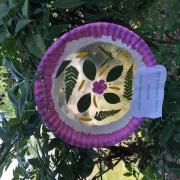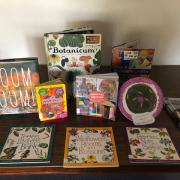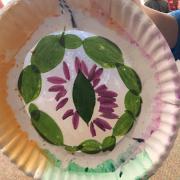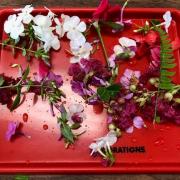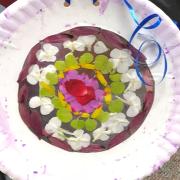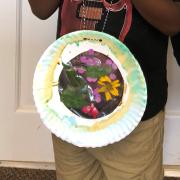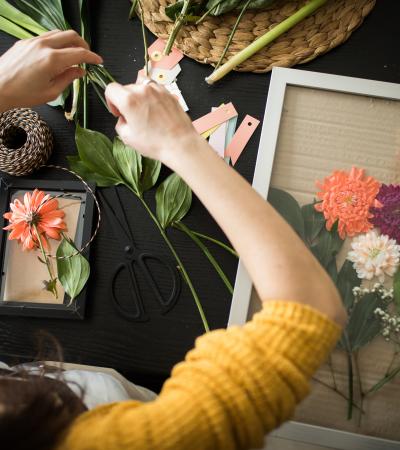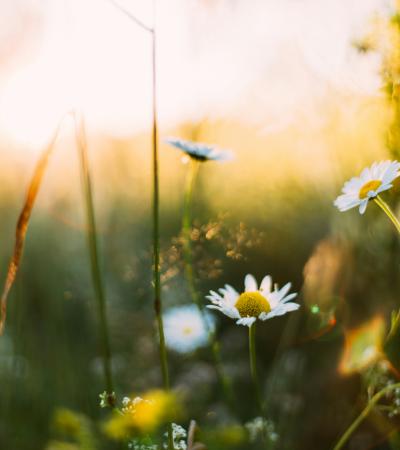Inspired by a project in Jean Van't Hul's book "The Artful Parent: Simple Ways to Fill Your Family's Life with Art and Creativity," children created colorful suncatchers with natural materials, clear contact paper and paper plates.
This is a simple and creative project for children and adults to complete together. When offered in person at the library, participants visited the library's garden to pick flowers, leaves and other natural items to use in their project.
Advanced Planning
All of our library programs are scheduled at least six months in advance. Detailed planning began two months before the program date, when we purchased materials, created a sample of the craft, prepared materials and advertised the program on social media.
Marketing
All library programs are advertised in a systemwide quarterly calendar of events. Individual programs are advertised in-house with paper fliers and on computer screens located at circulation desks. Program details are also posted to Facebook, Twitter and Instagram.
Youth services staff promote upcoming events at weekly story times. We also created suncatcher samples about one week before the event to hang at the circulation desk and in the children's area to spark interest in the program.
Budgeting
Our cost was under $25. The only purchase our library made was a roll of clear contact paper (for about $20); all other materials were already on hand.
The materials included clear contact paper; white paper plates (non-glossy); liquid water colors (or tempera paint thinned with water); paintbrushes; flowers, leaves and other natural materials; hole punchers; and ribbon, twine, string and/or yarn.
Day-of-event Activity
Set-up included preparing the tables with all the necessary materials and pulling books to create a display of related materials. Everything was handled by one youth services employee and one teen volunteer.
Weather was an unexpected challenge for us. Consider having a rain date or have staff/volunteers gather natural materials ahead of time in the event of bad weather.
Program Execution
We had rain on the day of the program, so we were unsure how many patrons would attend. The rain stopped shortly before the start of the event, and we had 20 attendees.
Participants gathered in the library meeting room and were given an overview of the project. Children used liquid watercolors to paint the paper plate that serves as a border.
While the paint dried, our teen volunteer led participants to the library's garden area to choose flowers and other natural materials while the staff member remained in the library. Since the garden was wet, we gave families the option of using pre-picked flowers or going outside. Most families braved the damp conditions and visited the library garden to gather materials.
Once back inside, adults helped children peel the contact paper's backing off. (Optional: staff could also peel and place the contact paper ahead of time.) Children and adults worked together to arrange natural materials on the sticky side of the contact paper.
Adults talked about the designs and colors with the children. Some children placed items randomly, while others made mandala or symmetrical designs.
When the designs were complete, adults helped children place a second sheet of contact paper over their designs to seal them. Then they punched a hole in the plate and added ribbon to make a hanger.
Advice
Create at least one sample ahead of time to familiarize yourself with the process. You may also wish to prepare most materials ahead of time (e.g., cut the paper plates, cut the contact paper to length).
There are ample opportunities to discuss related topics with this craft. For example, when providing the demonstration, you could talk about the concepts of mandalas and symmetry or the parts of a flower.
If your library doesn't have a garden or other outside area to pick flowers from, consider going on a nature walk as a group to gather items or ask participants to bring items from home. Consider asking your community garden club or a florist for donations of natural materials. If you do gather flowers and other items together, hand out baskets, trays, paper bags or other containers to place gathered materials in.
Remove leaves and petals from stems before adding them to your design. Flat materials work best.
Finally, if you have windows nearby, temporarily hang the completed suncatchers for children to see. This also creates a photo op area to take a picture of a child with their finished artwork.

